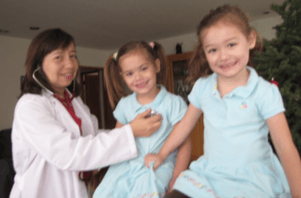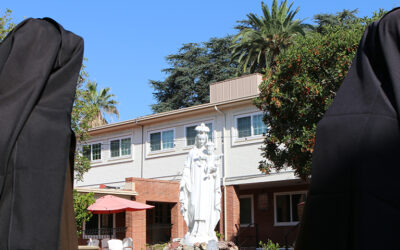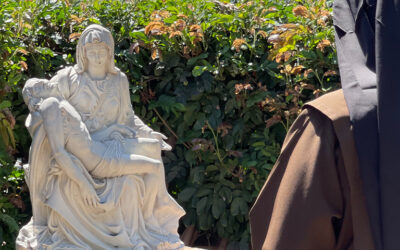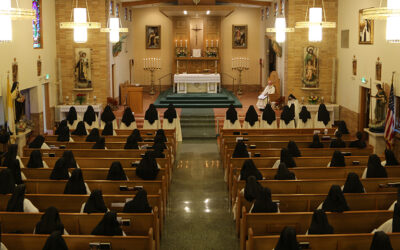by Althea Stresino, MD
When I was a medical student, I was resolute in becoming a family physician.
I regard the family unit as the most important in a society. It was my family who instilled in me my Chris- tian values and who helped me achieve my goal of being a physician. I am the second of twelve children, and my parents sacrificed financially so we would all get a Catholic education.
When I was in medical school completing my pediatric rotation, the nurses in the pediatric unit as well as the parents of my young patients urged me to become a pediatrician. They told me that they had observed my gentle manner and that children were comfortable and calm when I examined them. When it came time for me to choose my specialty, I followed their advice and went on to become a pediatrician. Today, I treat infants, small children, pre-adolescents and teenag- ers, providing medical care in three different settings – in the hospital to recently-delivered newborns, in a non-profit clinic, and in an urgent care setting.
I am also a secular Carmelite and apply my Carmel- ite spirituality to my profession. I envision every child I examine as the Christ Child. At that very moment, in that patient’s room – no matter which baby or what age – I am examining the baby Jesus’ ears, throat, and listening to the heart and lungs with my stetho- scope. I try to do this with thoroughness, gentleness, and love – as if I were Jesus’ own pediatrician. If a child is difficult (a crier, a fighter or a kicker) and it is too difficult to imagine the Christ Child, I offer the whole act of examining as a prayer and sacrifice to God.
My medical practice in California is negatively impacted by current California law. Many of the teenagers I see are sexually active, and I encounter several moral dilemmas when I converse with them. First, I need to ask questions about their sex life and their use of drugs and alcohol. Second, due to pri- vacy issues of the law, I may not share their responses with their parents.
Imagine this dilemma from the physician’s point of view. It is mind-boggling how this law was even passed in the first place. What is wrong with our society? Physicians’ hands are tied in this matter. We cannot share vital information with parents about their child (who is still a minor).
I do what I can by promising the teenagers I treat that if they are honest with me, I will respect their pri- vacy and not divulge their responses to their parents (by law I can’t). I feel, however, I may be promot- ing keeping secrets from their parents, so I encourage the teenagers to tell their parents everything because their parents love and support them. In addition, in- stead of promoting contraceptives, I encourage ab- stinence. I try to initiate a dialogue on morals and values. I tell them that even though their friends may have sex, use drugs, and drink alcohol, they should have the courage to stand up for the values their parents have taught them.
Other dilemmas I encounter are in regard to teenage girls who come into the clinic. Often these girls are pregnant and then I have the predicament of convincing them to continue with their pregnancy. Even though I offer them resources, they sometimes opt for an abortion. How do I know that these young patients ultimately go through with an abortion? I know because some of the girls come in to talk with me afterward, crying and regretting their decision.
I was able to prevent a couple of abortions.
One situation I remember distinctly is in regard to a 15 year-old-girl who already had a 9-month-old baby and I was the doctor for both mother and child. This girl asked what doctor I would recommend who performs abortions because she wanted to avoid any complications at a clinic. I answered, “I don’t refer to abortionists; I pray for them!” Instead, I referred her to the Shield of Roses, a non-profit Catholic organi- zation, which helps women decide for life. Shield of Roses assisted her financially during her pregnancy and, ultimately she had another little baby.
I am happy I became a pediatrician not only because I can make a difference in children’s physical health, but also because I can empower parents, children, and teenagers to stand up for their values and make ethical Christian choices.n
DID YOU KNOW?
The teenage pregnancy rate is 71.5 pregnancies per 1,000 women (ages 15 -19).
- The teenage birth rate is 41.9 births per 1,000 women (ages 15 -19).
- The teenage abortion rate is 19.3 abortions per 1,000 women (ages 15 -19).
- From 1986 to 2006, the proportion of teenage pregnancies ending in abortion declined almost one-third, from 46% to 32% of pregnancies among 15–19-year-olds.
- California reported the highest number of teen- age pregnancies (96,490).
- The newest and most detailed data on teen birth rates shows significant increases in 26 states and represents most regions of the USA. *From the January 2010 Guttmacher Institute Report (www.gutt- macher.org). The New York City-based Guttmacher Institute is a nonprofit that has been tracking abortions since 1974. Government abortion statistics are based on voluntary state reports and do not include every state.




